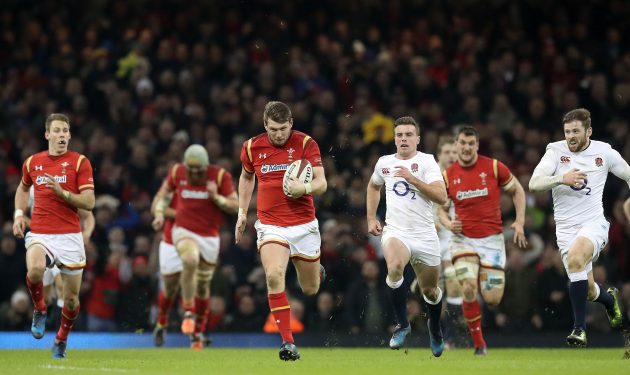England kept their remarkable winning run up but were closer than ever to losing it, so what could Rob Howley's men take from a fine, but ultimately losing performance?
The little things
Despite a rugby landscape dominated by 105kg wingers, fleets of Cryo-chambers and salaries approaching 1 million euros a season, rugby remains a game decided by the little things. And so it was when England beat Wales by 21- 16. 75 minutes of sterling work undone by 30 seconds of seeming minutiae. Despite the defeat, this was arguably Wales’ best performance of the past 12 months and maybe more. A performance with test level solidity at both the scrum and lineout and defensive completion of 91% – which is an enviable return against England’s myriad of heavy ball carriers. Wales’ backline, with Scott Williams at 12, took another step in a move towards more intricate backline play.

Cutting a line: Liam Williams scored a superb try before the break
Liam Williams’ try in the 38th minute was a perfect example of Wales’ new found ability in midfield. It was Scott Williams’ ‘triple-threat’ skillset sitting in the 12 channel that caught the attention of Owen Farrell, allowing Liam Williams to run a line so perfect that it could only have been improved had the English players lined it with red rose petals. But as good as the big things were, it was the little things that undid it all. Many will point to the final kick clearance in search of blame, but arguably the forward pass to Dan Biggar, which would have sent him straight under the posts was as important. If this Wales squad wants big things, they may have to start thinking little.
When substitutions go wrong
Taulupe Faletau’s arrival on the field, in the 53rd minute, changed the game. It wasn’t Faletau’s appearance that affected Wales, rather Ross Moriarty’s removal. Moriarty was arguably Wales’ most effective forward against England, even outperforming the ever-immaculate Alun-Wyn Jones, and was without doubt the most devastating defender.

Handful: Ross Moriarty gave England problems in attack and defence
Each of his ten tackles not only registered on the body of England’s players but also left a mark mentally – picking up Maro Itoje like he was a saggy old mattress is no mean feat. Moriarty’s removal seemed like one of those knee jerk substitutions that have become commonplace in modern rugby, where GPS data overtakes common sense and where the happenings on a computer screen supersedes what’s happening on the field. England would have been glad to see the back of Moriarty, which surely isn’t the point of a substitution.
Hat tip for Dan Biggar
Dan Biggar’s performance was hugely deserving of praise. A display made even more impressive given the pressure that he had been under in the six days previous. It can’t have been easy preparing for a test match knowing that many in Wales were calling for the apprentice, Sam Davies, to replace his master.

On the front foot: Dan Biggar had a spirited, brave game at 10 for Wales
Biggar’s kicking was immaculate, his distribution was neat and his interception in the 64th was one of the game’s heroic highlights. But as good as his attacking skills were, it was his defence that really stood out. Even amongst a squad where Justin Tipuric made 19 tackles, missing none, Biggar’s 14 tackles at outside half were standout. Many were, and remain, ready to right off Biggar long term, but those wishes may prove to be some way off.
Get. The. Ball. Off. The. Field.
Whether to kick the ball directly to touch and concede possession at the lineout, or to kick in-field and pressure the back three with a steady, straight defensive line provides significant debate in rugby circles. However, when you’re pinned behind your own try line, in the 75th minute, with tired players who are unlikely to be able to pressure the attacking team’s kick defence, there is no debate – the ball goes off the field.

Clinical: Elliot Daly profited from an errant kick out of defence late on
Many will unfairly blame Alex Cuthbert for his inability to tackle Elliot Daly on the kick return, but the mistake came at the previous ruck. One more additional phase on the Welsh try line would have allowed Dan Biggar to drop into position and given Leigh Halfpenny time to move infield and provide a second exit option. As it played out, Wales ended up with the left footed Jon Davies clearing to the left side of the pitch – the tight clearance angle and the fear of slicing it short, into touch, probably led directly to Davies’ kicking and infield. Wales cannot fail to learn from the cruellest of lessons.
Shorts and t-shirts?
If you see someone walking around a city centre, in the middle of winter, wearing shorts and a t-shirt, you can’t help but question their sanity. Or simply assume that they are studying a sports degree as those guys seem to live in shorts regardless of the time of year. Yet, in rugby we just accept it. When the whistle blew in Cardiff it was 2 degrees above zero.

Winter warmer: The temperature hovered above freezing, yet no player wore gloves
It was genuinely cold. Cold enough for people who are holding a pint of beer or a coffee to have to wear gloves, yet for those handling a rugby ball gloves are deemed unnecessary. It seems obvious that wearing a thin, warm, protective layer on the hands could only improve handling. The NFL is usually a good benchmark for elite sporting preparation and virtually all wide-receivers and running backs wear gloves – cold or not. So why not in rugby?






